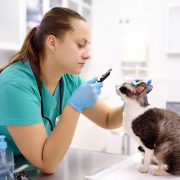BEVA primary care clinical guidelines: Diagnosis and management of equine pituitary pars intermedia dysfunction
BEVA primary care clinical guidelines: Diagnosis and management of equine pituitary pars intermedia dysfunction

our summary:
Menzies-Gow, N.J. et al. (2023) BEVA primary care clinical guidelines: Diagnosis and management of equine pituitary pars intermedia dysfunction. Equine Veterinary Journal.
The aim of these primary care clinical guidelines was to develop evidence-based clinical practice guidelines recommendations for the diagnosis and treatment of equine pituitary pars intermedia dysfunction (PPID).
Panel members, appointed by the editors of Equine Veterinary Journal, were asked to nominate clinical questions which were then grouped into four categories: accuracy of available diagnostic tests; interpretation of diagnostic test results; pharmacological agents for medical management of PPID and their side effects, and other treatment/management options; and monitoring of pergolide-treated cases. Panel members worked in pairs on a category developing the questions using the PICO framework and bibliographic searches were carried out on CAB Direct and PubMed, using a common search strategy adapted for each individual question. In addition, a search for evidence was carried out in VetSRev and Veterinary Evidence.
Studies relevant to the individual questions were assessed for quality of evidence using the Grading of Recommendations, Assessment, Development and Evaluation (GRADE) framework and assigned to one of the four GRADE levels of evidence: very low, low, moderate and high.
The panel pairs the drew up recommendations for their questions which were then presented at the BEVA congress for feedback from BEVA members. The final guidelines were approved by all panel members. Recommendations were categorised according to GRADE criteria and include:
- Case selection for diagnostic testing should be made by a combination of presenting clinical signs and horse age.
- Hypertrichosis or delayed/incomplete hair coat shedding are signs that provide a high index of clinical suspicion for PPID.
- For equids aged <10 years other potential causes of clinical signs should be investigated and diagnostic testing for PPID should only be considered in the presence of multiple compatible clinical signs that increase clinical suspicion.
- Clinical signs such as laminitis, bulging supraorbital fat and regional adiposity overlap with equine metabolic syndrome, and laboratory testing for insulin dysregulation should be performed in equids presenting with these signs.
- Thyrotropin-releasing hormone (TRH) stimulation tests for PPID should not be performed at intervals shorter than 24 hours. TRH stimulation are repeatable in non-autumn months but short-term variability in test results during autumn may limit diagnostic accuracy.
- Basal and post-TRH adrenocorticotropic hormone (ACTH) concentrations may be influenced by breed particularly in the autumn.
- Basal ACTH concentrations should not be measured immediately after transport.
- Geography and latitude also affect basal ACTH.
- Pergolide improves most clinical signs associated with PPID in most animals except laminitis.
- In most animals pergolide treatment lowers basal ACTH concentrations and improves the ACTH response to TRH stimulation.
These guidelines provide primary care practitioners with summaries of current evidence relating to the diagnosis and management of equine PPID and provide recommendations for a range of common clinical questions in this area. This review highlights the requirement for further high-quality studies across all areas of the diagnosis and treatment of PPID.
The following may also be of interest:
Sundra, T. et al. (2024) Retrospective assessment of the use of extended-release cabergoline in the management of equine pituitary pars intermedia dysfunction. Frontiers in Veterinary Science, 11. https://doi.org/10.3389/fvets.2024.1332337
Claiming CPD for reading inFOCUS articles
Reading and reflecting on articles can count towards your CPD, and we have a template to help you with the process.
Image copyright attribute: max5555








Leave a Reply
Want to join the discussion?Feel free to contribute!